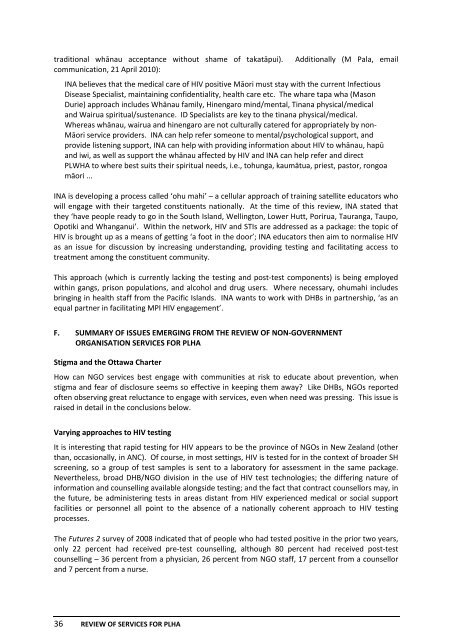Review of services for people living with HIV in New Zealand
Review of services for people living with HIV in New Zealand
Review of services for people living with HIV in New Zealand
- No tags were found...
You also want an ePaper? Increase the reach of your titles
YUMPU automatically turns print PDFs into web optimized ePapers that Google loves.
traditional whānau acceptance <strong>with</strong>out shame <strong>of</strong> takatāpui).communication, 21 April 2010):Additionally (M Pala, emailINA believes that the medical care <strong>of</strong> <strong>HIV</strong> positive Māori must stay <strong>with</strong> the current InfectiousDisease Specialist, ma<strong>in</strong>ta<strong>in</strong><strong>in</strong>g confidentiality, health care etc. The whare tapa wha (MasonDurie) approach <strong>in</strong>cludes Whānau family, H<strong>in</strong>engaro m<strong>in</strong>d/mental, T<strong>in</strong>ana physical/medicaland Wairua spiritual/sustenance. ID Specialists are key to the t<strong>in</strong>ana physical/medical.Whereas whānau, wairua and h<strong>in</strong>engaro are not culturally catered <strong>for</strong> appropriately by non‐Māori service providers. INA can help refer someone to mental/psychological support, andprovide listen<strong>in</strong>g support, INA can help <strong>with</strong> provid<strong>in</strong>g <strong>in</strong><strong>for</strong>mation about <strong>HIV</strong> to whānau, hapūand iwi, as well as support the whānau affected by <strong>HIV</strong> and INA can help refer and directPLWHA to where best suits their spiritual needs, i.e., tohunga, kaumātua, priest, pastor, rongoamāori ...INA is develop<strong>in</strong>g a process called ‘ohu mahi’ – a cellular approach <strong>of</strong> tra<strong>in</strong><strong>in</strong>g satellite educators whowill engage <strong>with</strong> their targeted constituents nationally. At the time <strong>of</strong> this review, INA stated thatthey ‘have <strong>people</strong> ready to go <strong>in</strong> the South Island, Well<strong>in</strong>gton, Lower Hutt, Porirua, Tauranga, Taupo,Opotiki and Whanganui’. With<strong>in</strong> the network, <strong>HIV</strong> and STIs are addressed as a package: the topic <strong>of</strong><strong>HIV</strong> is brought up as a means <strong>of</strong> gett<strong>in</strong>g ‘a foot <strong>in</strong> the door’; INA educators then aim to normalise <strong>HIV</strong>as an issue <strong>for</strong> discussion by <strong>in</strong>creas<strong>in</strong>g understand<strong>in</strong>g, provid<strong>in</strong>g test<strong>in</strong>g and facilitat<strong>in</strong>g access totreatment among the constituent community.This approach (which is currently lack<strong>in</strong>g the test<strong>in</strong>g and post‐test components) is be<strong>in</strong>g employed<strong>with</strong><strong>in</strong> gangs, prison populations, and alcohol and drug users. Where necessary, ohumahi <strong>in</strong>cludesbr<strong>in</strong>g<strong>in</strong>g <strong>in</strong> health staff from the Pacific Islands. INA wants to work <strong>with</strong> DHBs <strong>in</strong> partnership, ‘as anequal partner <strong>in</strong> facilitat<strong>in</strong>g MPI <strong>HIV</strong> engagement’.F. SUMMARY OF ISSUES EMERGING FROM THE REVIEW OF NON‐GOVERNMENTORGANISATION SERVICES FOR PLHAStigma and the Ottawa CharterHow can NGO <strong>services</strong> best engage <strong>with</strong> communities at risk to educate about prevention, whenstigma and fear <strong>of</strong> disclosure seems so effective <strong>in</strong> keep<strong>in</strong>g them away? Like DHBs, NGOs reported<strong>of</strong>ten observ<strong>in</strong>g great reluctance to engage <strong>with</strong> <strong>services</strong>, even when need was press<strong>in</strong>g. This issue israised <strong>in</strong> detail <strong>in</strong> the conclusions below.Vary<strong>in</strong>g approaches to <strong>HIV</strong> test<strong>in</strong>gIt is <strong>in</strong>terest<strong>in</strong>g that rapid test<strong>in</strong>g <strong>for</strong> <strong>HIV</strong> appears to be the prov<strong>in</strong>ce <strong>of</strong> NGOs <strong>in</strong> <strong>New</strong> <strong>Zealand</strong> (otherthan, occasionally, <strong>in</strong> ANC). Of course, <strong>in</strong> most sett<strong>in</strong>gs, <strong>HIV</strong> is tested <strong>for</strong> <strong>in</strong> the context <strong>of</strong> broader SHscreen<strong>in</strong>g, so a group <strong>of</strong> test samples is sent to a laboratory <strong>for</strong> assessment <strong>in</strong> the same package.Nevertheless, broad DHB/NGO division <strong>in</strong> the use <strong>of</strong> <strong>HIV</strong> test technologies; the differ<strong>in</strong>g nature <strong>of</strong><strong>in</strong><strong>for</strong>mation and counsell<strong>in</strong>g available alongside test<strong>in</strong>g; and the fact that contract counsellors may, <strong>in</strong>the future, be adm<strong>in</strong>ister<strong>in</strong>g tests <strong>in</strong> areas distant from <strong>HIV</strong> experienced medical or social supportfacilities or personnel all po<strong>in</strong>t to the absence <strong>of</strong> a nationally coherent approach to <strong>HIV</strong> test<strong>in</strong>gprocesses.The Futures 2 survey <strong>of</strong> 2008 <strong>in</strong>dicated that <strong>of</strong> <strong>people</strong> who had tested positive <strong>in</strong> the prior two years,only 22 percent had received pre‐test counsell<strong>in</strong>g, although 80 percent had received post‐testcounsell<strong>in</strong>g – 36 percent from a physician, 26 percent from NGO staff, 17 percent from a counsellorand 7 percent from a nurse.36 REVIEW OF SERVICES FOR PLHA
















